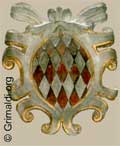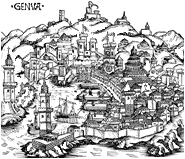|
Welcome
to Grimaldi.org, an official website of the ancient House of Grimaldi.
It provides an overview of nine centuries of Family history, and
outlines the genealogy of some of its main branches.
The
history of the Grimaldis is inextricably linked to those of Genoa and
Monaco whose House obtained independence and sovereignty. The echo of
this ancient name reverberates on distant seashores of Europe, from the
Black Sea to the Atlantic Ocean.
The House of Grimaldi — bearing a coat of arms described as fusilly
argent and gules (a pattern of red diamonds on a white background) —
descends from Grimaldo, a Genoese statesman at the time of the first Crusades. He was to pass his patronym from father to son for over 25 generations.
The earliest Genoese Annals — which are ancient manuscripts written in latin by Caffarus
— mention that Grimaldo, as well as his father and brother, had been
consul of Genoa. Little is known from earlier times with any level of
certainty.
The Republic of Genoa: The Roots of the Grimaldi
Despite
their bloody infighting — not unlike the Capulet and Montague depicted
by Shakespeare — the Genoese were of a single mind in the area of
exploiting commerce and banking opportunities. The power of their fleet
and the safety of their harbor allowed them to negotiate generally
favorable terms with the medieval rulers active in the Mediterranean
Basin.
 Genoa
had few rivals in the Mediterranean and rarely missed an opportunity to
consolidate that position whenever possible. Genoa's power crushed the
maritime ambitions of Pisa (1284) and confronted the fleet of its twin
rival, Venice, in four wars, which were as brutal as they were
inconclusive.
Genoa's initial commercial empire
stretched to the Western end of the Silk Road and came to spread across
most of Europe. Genoese merchants could be seen in Byzantium, in Syria
and in Africa, in London, and across to China and the New World, always
seeking a business opportunity. Their regular sea routes stretched from
the Black Sea to the North Sea, from Caffa and Cyprus to Bruges and
Antwerp.
The sheer number of colorful characters and
defining events — political, military and economic — makes the epic of
the Grimaldi family remarkable. It provides an unusual, sometimes
surprising view of European history in the perspective of an entire
millennium.
Grimaldo, Founder of the House of Grimaldi
The
Grimaldis emerged from the Crusades as one of the four major ruling
families of the Genoese urban nobility, essentially warriors,
shipowners, and bankers. Genoa experimented with several political
systems to organize its City-State and, around the 11th century, chose
the Commune.
As such, the City was led by a committee of consuls who were generally
chosen among the feudal families that had settled down in the City.
Grimaldo, who gave his patronymic name to his descendants, was the
youngest son of Otto Canella, a Consul of Genoa in 1133. In turn,
Grimaldo rose up to become consul three times, in 1162, 1170 and again
in 1184. The prominence of Grimaldo in the City's public affairs led
him to be sent in embassy to negotiate some of the most important
treaties with foreign rulers, such as the Emperor Frederick Barbarossa
and the Emperor of Byzantium. Oberto Grimaldi, son of Grimaldo, is the
first of the family known to use the patronymic Grimaldi.

As
in other Italian cities of the time, the need for political weight in
the Commune pushed the Genoese nobility to pull their forces into
parties representing their views. Between the 13th and 14th centuries,
the Genoese families thus developed the albergo, an
organizational structure incorporating several small families around a
prominent House, such as the Grimaldis, that shared the same political
and economical interests. In Genoa, the members of an albergo typically lived in the same neighborhoods and attended the same churches, which further reinforced the close ties.
During
the power struggles between the papacy and the Holy Roman Empire, the
Grimaldis and the Fieschis led the pro-papal Guelph party against the
Emperor whose interests were backed by the Ghibelline Doria and Spinola
families. In 1270, in the midst of one of those numerous political
struggles, the Guelphs were forced into exile: the Grimaldis and their
allies took refuge in Guelphic towns of the Western Riviera, around
Nice. From the viewpoint of history, the exile of 1270 appears to be
the main starting point for the old feudal branches of the House of
Grimaldi, such as Monaco, Boglio, and Antibes, in the 13th and 14th
centuries. By 1333, the Grimaldi Family had grown to over 100 men.
The Epic History of the Main Branches
The
fortune of merchant noblemen relied on maritime trade and access to
fortified ports, like Monaco and Antibes, where they could also raise
their armies. In 1297, a group of Grimaldi and Guelphic allies
therefore sought to seize the fortress of Monaco
at the tip of their sword from the Ghibellines, turning the place into
a base for political activism and military operations against their
Genoese rivals. Over the next centuries, however, the albergo alternately lost and regained control of Monaco during a period of instability and wars throughout the region.
In
1419, the Grimaldis succeeded in permanently securing possession of
Monaco, and stubbornly embarked on defending its independence,
sometimes at the price of their personal freedom or their life. As
often for all the feudal possessions of Genoese families in Provence,
Liguria and Corsica, the Grimaldis ruled over Monaco with the title of signori,
or lords, and only assumed the title of prince in the 17th century. The
princely title can also be found among the distinctions of other
branches of the Grimaldi Family, although traditionally the Grimaldis —
and the Genoese nobility in general — carried few titles. However,
owing to its long independence and the prestige associated with its
sovereignty, the principality of Monaco undoubtedly rose to become the
jewel of the House of Grimaldi.
The history of Monaco
and of the Grimaldis was largely symbiotic until the 17th century, when
a first controversial act of succession saw Jacques de Goyon Matignon
climbing the throne of the principality. Before long, the French
Revolution rolled over Europe and annexed the principality. Monaco was
however reinstated when quieter times returned in the wake of the
Napoleonic Wars. In the 20th century, in another turn of events, a new
succession affair brought to the throne the current dynasty, issued
this time from the Polignacs. (Read more)
The Kingdom of Naples and the fertile island of Sicily
were strategically located on the Mediterranean trade routes; this fact
did not escape the Genoese merchants. The long presence of the
Grimaldis in Sicily goes back to the 14th century, where they served as
advisors and captains of justice, or in battle on the side of the
Angevin kings.
Wedged in the Alps between France, Provence, Savoy, and Piedmont, the fiefdom of Boglio
(Beuil, in today's France) was among the largest in the region. In the
early 14th century, a marriage with the heiress of Boglio brought
this territory to the Grimaldis. Quickly, they went on an expansion
spree that regularly put them at war with their neighbors.
In a fascinating page of diplomatic history, those Grimaldis managed to bring peacefully the entire Nice
country — originally part of Provence — to the counts of Savoy in what
is called the "Dedition of Nice" (1388). The Grimaldis governed the
region of Nice at a time of war when their "lord," the king of Hungary,
could not come to the rescue of his subjects. With the help of the
Grimaldis, Nice and other nearby towns put themselves under the
protection of the Count of Savoy. As a result, landlocked Savoy and
Piedmont acquired a reliable access to the sea. The Grimaldi of Boglio
received therefore over 20 fiefdoms and reinforced their gubernatorial
position in Nice.
With a legendary determination, they
eventually patched together a small "kingdom," to which only
independence was missing. Hearing about those maneuverings, the counts
of Savoy put a mortal end to this branch's ambitions in the 17th
century. (Read more)
Earlier, in the 14th century, the Grimaldis also received possession of the ancient city of Antibes —
as collateral to a loan made to a pope. They established a branch of
marquises in Provence that produced several knights of Malta, as well
as governors and bishops. Two centuries later, descendants of the lords
of Antibes spread over the Alps to Piedmont. They acquired the old
fiefdom of Puget in Provence (Pogetto,
in Italian), of which they still bear the name of Puget to this day.
More sword than robe, they produced a long line of officers that, for
instance, could be found serving in the royal armies of Savoy, the
imperial army of Napoleon or fighting for the independence of Italy.
The campaign of 1848 did not turn to the revolutionaries' advantage,
however, and several of their leaders ended up in exile to Brussels in Belgium. (Read more)
Representatives
of an international and business-savvy nobility, the Grimaldis were
active as early as the Late Middle Age in all the large political and
economic centers of Europe, notably Byzantium, France, Spain, the
Netherlands and England.

In Genoa,
the Grimaldis participated in the creation of the Bank of Saint George
— one of the first incorporated banks in the world, founded in 1407 —
and financed popes, kings, and emperors, including Charles V of Spain.
At the time of the constitutional reform of 1528, which gave birth to
the aristocratic Republic of Genoa with the support of the Habsburg
Crown, the Grimaldis were put at the helm of one of the 28 alberghi. As such, they could participate in the government of the Republic and run in the biennial election of the Doge, the Genoese presidency. These Genoese patricians were listed in the Liber Civilitatis (later called Liber Nobilitatis) and exercised the sovereignty of the Republic until the troops of Napoleon entered Genoa.
The
Grimaldis were involved in most of the great enterprises of those
times, including the colonial ventures to the New World, until the
costly bankruptcy of Philip II's Spanish Treasury. We owe them several
of the most important palaces of Genoa, such as the superb Tursi
Palace, which now hosts the town hall.
After the reform of 1576 that abolished the alberghi, the Family continued to manage the common patrimony of the ancient albergo
— composed of Oberto Grimaldi's descendants and their accredited
allies, such as the Cebà and Oliva families — and its members still
enjoyed glorious years until the French revolution. The Grimaldis kept
serving in finance as well as in public service for the Republic of
Genoa, the Spanish Empire and the Roman Catholic Church, frequently
rising to the highest functions. In Spain,
for example, Charles III chose a Grimaldi of Genoa — who would
later become prime minister of Spain from 1763 to 1777 — to negotiate
an alliance with the king of France, Louis XV, causing Spain to enter
the war with England at the eve of the American insurrection.
Other branches also deserve a place in this historical overview of the Grimaldi Family. They settled, for example, in Bologna, Carignano, Régusse, and London, this last branch being more extensively covered in the genealogical section of this site. (Read more)
Some
authors also mention branches in remote regions, for which the lack of
documents unfortunately makes any serious genealogical study difficult.
The Grimaldi name is indeed not uncommon.
Paradoxically,
the large House described in these pages has almost entirely
disappeared. According to independent genealogists, most of the
legitimate branches mentioned in this overview are now extinct.
Another
paradox is that the jewel of the House of Grimaldi, Monaco, has managed
to preserve its independence through most wars and revolutions. Wedged
between snow-white summits and a glittering sea, Monaco and its Monégasques are living proof that small States have their place in the concert of nations.
|

